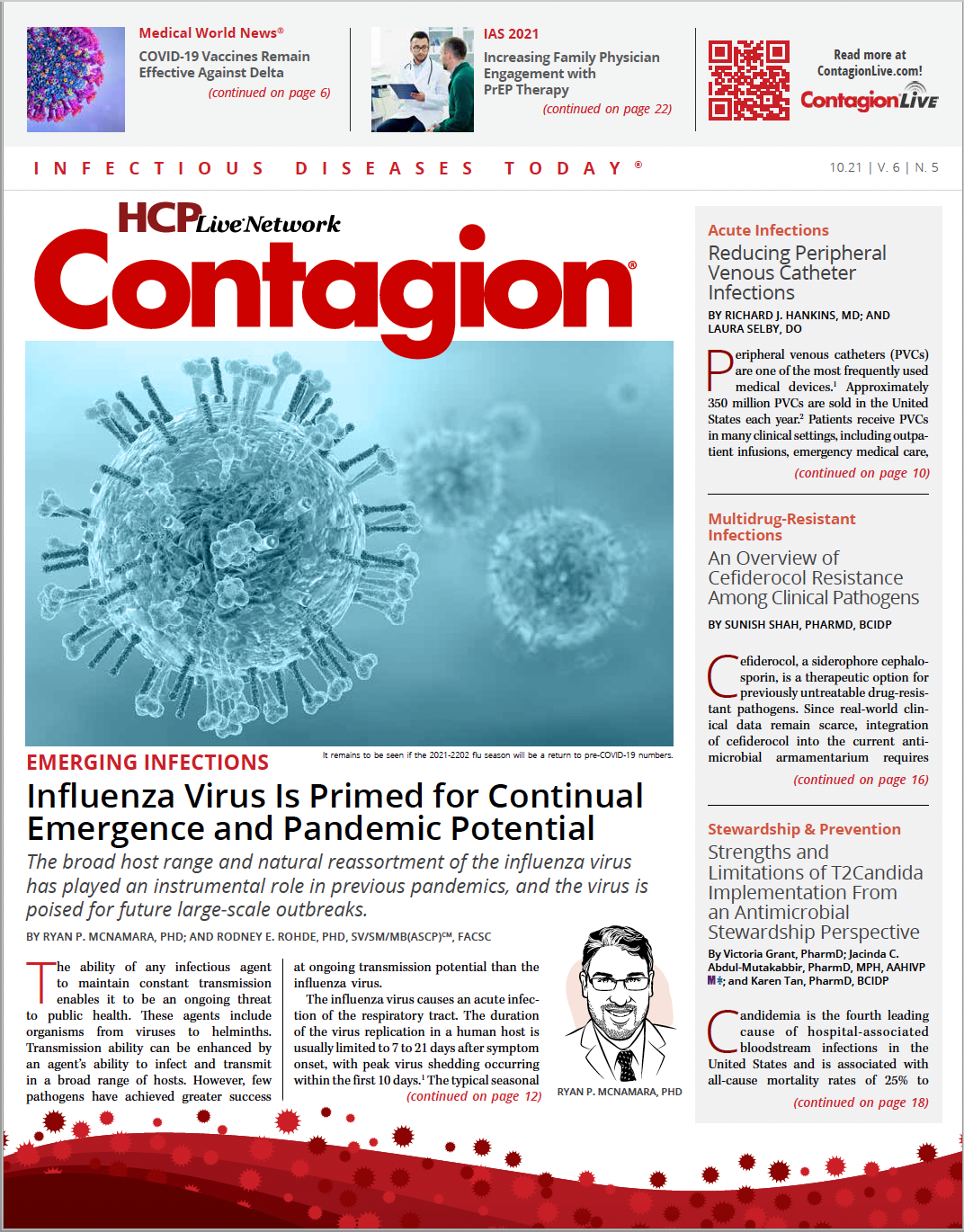What Is the Ideal Duration of Daptomycin and Ceftaroline Combination Therapy for MRSA Bacteremia?

Staphylococcus aureus is the leading cause of bloodstream infections worldwide, associated with a high incidence of metastatic infections such as infective endocarditis and osteomyelitis.1,2 The Infectious Diseases Society of America clinical guidelines for the management of MRSA infections endorse the use of vancomycin or daptomycin as standard therapy for MRSA bacteremia.3 However, recent studies have shown that a combination of standard therapy plus an antistaphylococcal β-lactam (eg, nafcillin, cefazolin) may enhance bactericidal activity and improve outcomes, such as reduced duration of bacteremia, recurrence, and mortality in patients with persistent MRSA bacteremia.4,5 Proposed mechanisms include β-lactam-induced reduction in cell wall cross-linking, allowing increased daptomycin and vancomycin binding and β-lactam synergy with cationic host defense peptides against MRSA.6
Ceftaroline has emerged as a preferred β-lactam combination agent because of its intrinsic activity against MRSA. A growing body of literature supports dual therapy with daptomycin and ceftaroline for persistent MRSA bacteremia. An in vitro study by Werth et al showed that combination of daptomycin plus ceftaroline had rapid and sustained bactericidal activity against MRSA by enhancing daptomycin-induced depolarization and organism killing.7 The authors proposed that the rapid and complete reduction in high bacterial inoculum may facilitate de-escalation to monotherapy, which may be preferred for infections that require weeks of treatment. However, large studies have yet to confirm these theories.
A retrospective study comparing daptomycin/ceftaroline therapy to standard of care monotherapy in MRSA bacteremia found numerically lower 30-day mortality in patients switched to combination therapy within 72 hours of index culture compared with standard of care (8.3% vs 14.2%, P> 0.05).8 However, the median duration of positive blood cultures was 9.3 vs 4.8 days for combination and standard of care groups, respectively. Further analysis showed that combination therapy was initiated on day 6, with a mean duration of bacteremia of 3.3 days after initiation, leading the investigators to conclude that early initiation of daptomycin plus ceftaroline may benefit patients at high risk of mortality. Although combination therapy with daptomycin and ceftaroline has been shown to reduce bacterial burden and improve clinical outcomes, the ideal duration of therapy has yet to be elucidated.
Nichols and colleagues attempted to clarify whether continued combination therapy with daptomycin and ceftaroline following bacteremia clearance is preferred over de-escalation to monotherapy.9 All patients received at least 72 hours of combination therapy. The combination group was defined as receiving 10 or more days of therapy, and the monotherapy group received 3 to 10 days of combination therapy before de-escalation to vancomycin, daptomycin, or ceftaroline monotherapy. Notable exclusion criteria included de-escalation before blood culture clearance, transition to hospice, no bacteremia clearance before death, less than 10 days of total antibiotic therapy, polymicrobial bacteremia, recurrent MRSA bacteremia, and combination therapy within 1 year prior to admission. The primary outcome was a composite of inpatient infection-related mortality, 60-day readmission, and 60-day bacteremia recurrence. Secondary outcomes included a comparison of adverse drug events and hospital length of stay.
The study included 140 patients—66 (47%) in the combination group and 74 (53%) in the monotherapy group. The monotherapy group consisted of 18 ceftaroline-, 30 daptomycin-, and 26 vancomycin-recipients. Although more patients in the combination group had a history of intravenous (IV) drug use (58% vs 36%; P= .01), higher rates of endocarditis (56% vs 35%; P= .01) and pulmonary septic emboli (47% vs 27%; P= .01), and positive MRSA sputum cultures (36% vs 19%; P= .01), severity of illness scores were similar. The median duration of combination therapy before de-escalation in the monotherapy group was 4.5 days.
The median total antibiotic duration was 56 days for the combination group vs 45 days for the monotherapy group (P= .5). There was no statistically significant difference in the primary composite outcome between the combination and monotherapy groups (21% vs 24%; P= .66) nor after multivariable logistic regression controlling for IV drug use (OR, 2.24; 95% CI, 0.93-5.43) and chronic kidney disease (OR, 2.20; 95% CI, 0.87-5.57). Readmission rates were similar in the combination group vs monotherapy group (20% vs 18%; P =.75). Recurrence of bacteremia occurred in 2 patients in the combination group and 5 patients in the monotherapy group (3% vs 7%; P= .45). Inpatient infection-related mortality was 2% in the combination group compared with 5% in the monotherapy group (P= 1.0). No statistically significant differences in adverse drug events or inpatient length of stay were observed between groups.
This is the first in vivo study to evaluate the duration of combination therapy with daptomycin and ceftaroline for persistent MRSA bacteremia showing no significant difference in clinical outcomes when patients are de-escalated to monotherapy within 3 to 10 days after blood culture clearance. Although up to 10 days of combination is generous for a definition of “monotherapy,” most patients only received 4.5 days prior to de-escalation, with inference of blood culture clearance. It’s worth noting that there was no report of antimicrobial dosing regimens or vancomycin therapeutic drug monitoring. The institution did not have an outpatient parenteral antimicrobial therapy program before 2017, which may have presented barriers to continuing therapy after discharge, such as insurance coverage and therapeutic drug monitoring. Regardless of these limitations, this study supports de-escalation from combination to monotherapy 3-10 days after MRSA bacteremia clearance. Given the high administration burden and costs that may be associated with combination therapy, future analyses of adherence and pharmacoeconomic outcomes may provide further insight into the appropriate timing of de-escalation to monotherapy for MRSA bloodstream infections.
Highlighted Study: Nichols CN, Wardlow LC, Coe KE, Sobhanie MME. Clinical outcomes with definitive treatment of methicillin-resistant Staphylococcus aureus bacteremia with retained daptomycin and ceftaroline combination therapy vs de-escalation to monotherapy with vancomycin, daptomycin, or ceftaroline. Open Forum Infect Dis. 2021;8(7):ofab327. doi:10.1093/ofid/ofab327
References
- Diekema DJ, Hsueh PR, Mendes RE, et al. The microbiology of bloodstream infection: 20-year trends from the SENTRY Antimicrobial Surveillance Program. Antimicrob Agents Chemother. 2019;63(7):e00355-19. doi:10.1128/AAC.00355-19
- Hassoun A, Linden PK, Friedman B. Incidence, prevalence, and management of MRSA bacteremia across patient populations-a review of recent developments in MRSA management and treatment. Crit Care. 2017;21(1):211. doi:10.1186/s13054-017-1801-3
- Liu C, Bayer A, Cosgrove SE, et al. Clinical practice guidelines by the Infectious Diseases Society of America for the treatment of methicillin-resistant Staphylococcus aureus infections in adults and children: executive summary. Clin Infect Dis. 2011;52(3):e18-e55. doi:10.1093/cid/cir034
- Davis JS, Sud A, O'Sullivan MVN, et al. Combination of vancomycin and β-lactam therapy for methicillin-resistant Staphylococcus aureus bacteremia: a pilot multicenter randomized controlled trial. Clin Infect Dis. 2016;62(2):173-180. doi:10.1093/cid/civ808
- Jorgensen SCJ, Zasowski EJ, Trinh TD, et al. Daptomycin plus β-lactam combination therapy for methicillin-resistant Staphylococcus aureus bloodstream infections: retrospective, comparative cohort study. Clin Infect Dis. 2020;71(1):1-10. doi:10.1093/cid/ciz746
- Geriak M, Haddad F, Rizvi K, et al. Clinical data on daptomycin plus ceftaroline versus standard of care monotherapy in the treatment of methicillin-resistant Staphylococcus aureus bacteremia. Antimicrob Agents Chemother. 2019;63(5):e02483-18. doi:10.1128/AAC.02483-18
- Werth BJ, Sakoulas G, Rose WE, Pogliano J, Tewhey R, Rybak MJ. Ceftaroline increases membrane binding and enhances the activity of daptomycin against daptomycin-nonsusceptible vancomycin-intermediate Staphylococcus aureus in a pharmacokinetic/pharmacodynamic model. Antimicrob Agents Chemother. 2013;57(1):66-73. doi:10.1128/AAC.01586-12
- McCreary EK, Kullar R, Geriak M, et al. Multicenter cohort of patients with methicillin-resistant Staphylococcus aureus bacteremia receiving daptomycin plus ceftaroline compared with other MRSA treatments. Open Forum Infect Dis. 2019;7(1):ofz538. doi:10.1093/ofid/ofz538
- Nichols CN, Wardlow LC, Coe KE, Sobhanie MME. Clinical outcomes with definitive treatment of methicillin-resistant Staphylococcus aureus bacteremia with retained daptomycin and ceftaroline combination therapy vs de-escalation to monotherapy with vancomycin, daptomycin, or ceftaroline. Open Forum Infect Dis. 2021;8(7):ofab327. doi:10.1093/ofid/ofab327

